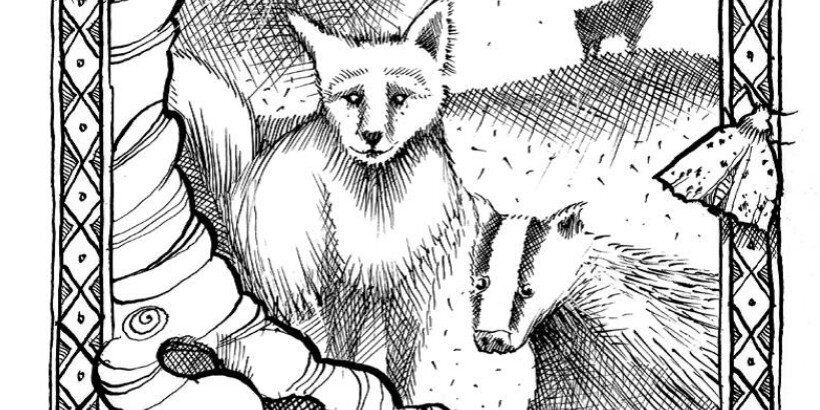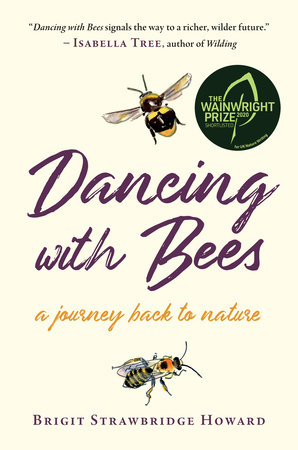How to Walk Like a Fox and See in the Dark

The fun doesn’t have to end when the sun goes down. There is a whole other world to explore when night settles in. In Chris Salisbury’s book Wild Nights Out, he offers guidance, ideas, challenges to try and games to play at dusk and in the dark.
For grown-ups, children, and anyone in between, these activities are designed to help you become in tune with your body and the dark like circle walking, or with the surrounding wildlife, like fox-walking.
The following is an excerpt from Wild Nights Out by Chris Salisbury. It has been adapted for the web.
(Illustrations courtesy of Stewart Edmondson unless otherwise noted.)
Attunement Activities In the Dark
Here is an activity designed to provide a direct, one-to-one experience of the outdoors at night. Your discretion as group leader will be required as to the use of torches during these activities. Relying on one’s night vision can be a rich part of the experience for people as they walk through the darkness. But on some occasions, such as on darker nights, it will be appropriate to invite the responsible use of a torch to help people find their way.
Circle Walk

Ages: 11 and up
Number of participants: 6–30
A circle walk creates a container that allows the group to safely explore some solo time with some navigational simplicity. Offering this activity during the twilight hours might be preferable to the challenge of darkness. Judgement must be used as to when a group is ready for solo night navigation. Use your discretion – this activity is not meant to challenge unduly.
Walk the group in a wide circle around a predetermined central point, for example the campfire or base camp. Drop them off one by one, spaced apart equidistant from each other around the circumference of the circle you are walking. How far away from the central point you go will depend on the terrain and the capacities of the group. Ideally, the group members will not be able to see the central point of the circle from their drop-off spot. On a given signal, they simply make their way from their drop-off location back to the central point, using their ‘night eyes’ to find their way. Best if they can be given enough time to dwell, pause, linger and bathe in the night if they choose, rather than rushing back. Invite this to be part of the experience, and suggest they might take note when or if they stray out of their comfort zone in this activity, to reflect on later.
Use a signal, such as a whistle, for calling everybody back after a certain amount of time. The time you allow will be dictated by factors including the terrain, size of the circle, age range and group capacities, but approximately 30 minutes is a guideline.
When everyone has returned, take time to reflect together on their experiences, ideally seated around a campfire.
Silent Movement Games
Let’s move on now to the matter of movement, or more precisely, the subject of sneaking. These games in particular demonstrate that learning can be fun and are helpful in bringing children’s high energy down to appropriate levels for a nightwalk. Some of them are variations on games that you may well have played in childhood, but many are much older than that. These are exactly the sort of games I believe our indigenous ancestors would have played with their children as a way of practicing essential skills and building awareness of predator and prey. Humans then were not the top of the food chain in many wilderness environments, and they had to be mindful of what might be stalking there. Learning the art of invisibility was an essential skill, as was learning how to move quietly towards animals and birds they wanted to catch and eat.
FOX-WALKING
Equipment required: None
Ages: 8 and up
Number of participants: 2–20
Teaching your companions how to fox-walk will pay dividends on any mission to get closer to wildlife, not least on a nightwalk when the target species have a highly developed sense of hearing. The simple idea of this exercise is to learn how to move silently through the undergrowth in a woods or forest. I advise spending the first bit of time directing the group’s attention to the way they all walk naturally when they are not concentrating on being quiet, so that they can ‘unlearn’ this and instead copy how a fox might walk.
Ask the group to mill about, walking normally, and then encourage them to listen to the sounds their bodies and clothing make as they do so. Next, request the group continue to walk normally but this time to put their fingers in their ears, so they can ‘hear’ themselves ‘on the inside’. This sounds strange I know, but it’s very informative. Try it yourself ahead of time and you’ll see how ‘noisy’ our walking is when experienced this way.
Tell the group to stop walking and gather around you. Now it’s time to analyze ‘normal’ walking. Demonstrate how a person usually places their heel down first when walking along, followed by a roll of the foot towards the toes. Then demonstrate a fox-walk, which necessitates placing the toes down first, and then rolling the foot back towards the heel.
Get everyone in the group to try out fox-walking and experience the effect it has on their movement. They should notice right away that it necessitates slowing down from their usual walking pace. Next, ask the group to block their ears again and see what they hear and whether it’s different.

Demonstrate how to maintain weight on the standing foot, which enables us to explore the terrain under the toe of the forward foot and to consciously shift over our weight when it’s safe to do so. Explain that in this way, we can quickly raise our foot if we suspect the transference of our weight will break a stick or leave us unbalanced on a stone.
Ask the group to practice consciously this method of weight transfer so that they retain precision control on each step. You can turn this into a little game by calling out ‘freeze!’ every so often, which will invariably cause some of your companions to practice balancing on one leg for a few seconds.
Here’s one more challenge to present: stalking wildlife may well involve keeping your eyes up and focused on the creature you are stalking, rather than looking at your feet. (I’ve been caught out many times by looking down at the ground to secure my footing, only to realize I had lost sight of the deer or fox I was trailing when I looked up again.)
Ask the group to continue fox-walking but to now attempt it without looking at the ground. This presents a new challenge for our sense of balance, which instinctively harnesses our eyes to assist, but now requires our feet to ‘see’ the ground on which we are walking.
Notes and Variants
One last variation of fox-walking is to travel with your hands clasped either behind your back or in front of you. The point is to avoid moving your arms to help with balance. Any wild mammal or bird you might pursue will be very sensitive to movement. Keeping your hands joined together will not only reduce your visual profile, it will also prevent you from inadvertently drawing the creature’s attention to your presence. It’s not easy to fox-walk this way, so be patient as you practice. It may not be appropriate to ask every group to achieve this level of quiet and focus, and you’ll need to decide whether a night-time fox-walk is appropriate. Fox-walking outdoors at night may be too ambitious with a class of young schoolchildren, for example. It’s still a fun exercise to practice, though, and introduces some basic principles to remember in terms of getting close to wildlife. It is also a skill they can ‘take away’ to practice on their own and teach others.
Recommended Reads
Recent Articles
The fig tree is more than just a fruit-bearing wonder. The complex nature of these trees is beyond fascinating. They are the ultimate ecosystem superheroes!
Read MorePumpkins: Halloween symbol or sweet treat? But have you ever wondered how they became a holiday staple? Discover the rich history behind this fall favorite!
Read MoreHave you ever wondered why fig trees are considered a symbol of abundance and fertility across cultures? What exactly makes these trees so special?
Read MoreSeeds strengthen our connections to what we grow and eat; they are intrinsic to our identity and our future. I cherish seed as a common resource that all the world should be able to access freely.
Read MoreCultivating mushrooms on various substrates has many benefits — from composting, mycoremediation, and creating value-added consumer goods. It helps reduces waste and helps the environment!
Read More









